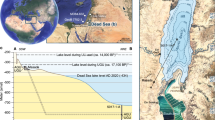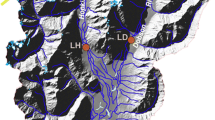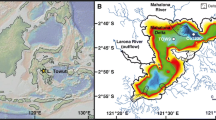Abstract
The Prespa Lake Basin (southwestern Balkans) contains a unique Holocene beach ridge record, which offers the opportunity to reliably reconstruct past water-level fluctuations based on absolute geomorphic stage index points. Such lake-level records are of great value for generating robust (quantified) hydro-climatic interpretations. These are urgently required for the Balkans, located at the juncture of contrasting Mediterranean climate and hydrological domains, as the few regional lake-proxy records covering the past millennium lack chronological resolution and appear to show different timing of wet-dry episodes. In order to use lake stage records for past climate change reconstructions, it is vital to understand modern lake-level sensitivity to specific hydro-climatic events and to track this signal to the landform-sediment archive. Accordingly, this paper analyses the impact of recent hydro-climate variability on the level of Lake Megali Prespa and traces this water-level signal to modern beach ridge sediments to facilitate future lake-level reconstructions. Annual lake fluctuations are strongly related to cumulative wet season precipitation which is highly correlated to the North Atlantic Oscillation. Lake Prespa reacts to sustained water balance changes by adjusting its lake surface area and thus surface evaporation. Historical water levels fluctuated between 853 and 842 m. Within this height range, lake surface areas change abruptly at 853–852, 847–846 and < 842 m. At stage levels in between these thresholds, set by the bathymetry, lake surface area only changes marginally and hydro-climatic conditions are approximately stable. This study finds that lake-level fluctuations are reliably registered by lacustrine beach sediment facies. Major lake level movements, which cross bathymetric thresholds, are clearly registered in the sediment-stratigraphic record by characteristic truncation surfaces and deposits. The chronological resolution of this lake-level record, and therefore the hydro-climatic signal it contains, is up to decadal timescales. Establishing quantified hydrological change estimates from the Prespa beach-ridge record requires knowledge of lake surface areas at specific lake stage index points. Modern analogues will give the difference in annually evaporated lake water volume between key stages. These differences are approximately equivalent to the change in water input (precipitation and discharge) and/or water loss (evaporation).






Similar content being viewed by others
References
Amataj S, Anovski T, Benischke R, Eftimi R, Gourcy LL, Kola L, Leontiadis I, Eftim M, Stamos A, Zoto A (2007) Tracer methods used to verify the hypothesis of Cvijic about the underground connection between Prespa and Ohrid Lake. Environ Geol 51:749–753
Andrew PB, van der Lingen GJ (1969) Environmentally significant sedimentologic characteristic of beach sands. N Z J Geol Geophys 12:119–137
Argyilan EP, Forman SL, Thompson TA (2010) Variability of Lake Michigan water level during the past 1000 years reconstructed through optical dating of a coastal strandplain. The Holocene 20(5):723–731
Aufgebauer A, Panagiotopoulos K, Wagner B, Schaebitz F, Viehberg FA, Vogel H, Zanchetta G, Sulpizio R, Leng MJ, Damaschke M (2012) Climate and environmental change in the Balkans over the last 17 ka recorded in sediments from Lake Prespa (Albania/F.Y.R.O.M./Greece). Quat Int 274:122–135
Ballarini M, Wallinga J, Murray AS, van Heteren S, Oost AP, Bos AJJ, van Eijk CWE (2003) Optical dating of young coastal dunes on a decadal time scale. Quat Sci Rev 22:1011–1018
Bronk-Ramsey C (2009) Bayesian analysis of radiocarbon dates. Radiocarbon 51:337–360
Campbell CV (1967) Lamina, laminaset, bed and bedset. Sedimentology 8:7–26
Carter RWG (1986) The morphodynamics of beach-ridge formation: Magilligan, Northern Ireland. Mar Geol 73:191–214
Charou E, Katsimpra M, Stefouli M, Chiono A (2010) Monitoring lake hydraulics in West Macedonia using remote sensing techniques and hydrodynamic simulation. In: Hydraulics Environmental (ed) Christodoulou and Stamou. Taylor & Francis Group, London, pp 887–892
Chavkalovski I (2000) Anthropogenic influence on the denivelation of Lake Makro and Mikro Prespa. In: Grupce L, Kungulovski D (eds) Proceedings of the international symposium on sustainable development of the Prespa region, Oteshevo. Macedonian ecological society, Resen, pp 250–257
Dai A, Trenberth KE, Qian T (2004) A global dataset of Palmer Drought Severity Index for 1870–2002: relationship with soil moisture and effects of surface warming. J Hydrometeorol 5:1117–1130
Dean JR, Eastwood WJ, Roberts N, Jones MD, Yiğitbaşıoğlu H, Allcock SL, Woodbridge J, Metcalfe SE, Leng MJ (2015) Tracking the hydro-climatic signal from lake to sediment: a field study from central Turkey. J Hydrol 529:608–621
Diciccio TJ (1996) Bootstrap confidence intervals. Stat Sci 11:189–228. https://doi.org/10.1214/ss/1032280214
Enzel Y, Bookman R, Sharon D, Gvirtzman H, Dayan U, Ziv B, Stein M (2003) Late Holocene climates of the Near East deduced from Dead Sea level variations and modern regional winter rainfall. Quat Res 60:263–273
FAO/UNESCO (1963) Carte Bioclimatique de la zone Mediterranee: notice explicative. O.N.M, Paris
Fritz SC (2008) Deciphering climate history from lake sediments. J Paleolimnol 39:5–16
Graham J (1988) Collection and analysis of field data. In: Tucker ME (ed) Techniques in sedimentology. Blackwell Scientific Pub, London, pp 5–63
Hollis GE, Stevenson AC (1997) The physical basis of the Lake Mikri Prespa systems: geology, climate, hydrology and water quality. Hydrobiologia 351:1–19
Hurrell J, National Center for Atmospheric Research Staff (eds) Hurrell Station-based monthly North Atlantic Oscillation Index Data provided by the Climate Analysis Section, NCAR, Boulder, USA. https://climatedataguide.ucar.edu/climate-data/hurrell-north-atlantic-oscillation-nao-index-station-based#sthash.mveI0Wlp.dpuf. Accessed 20 Dec 2015
Jacobs Z (2008) Luminescence chronologies for coastal and marine sediments. Boreas 37:508–535
Jarvis A, Reuter HI, Nelson A, Guevara E (2008) Hole-filled SRTM for the globe Version 4, available from the CGIAR-CSI SRTM 90 m Database. http://srtm.csi.cgiar.org
Johnston JW, Köster D, Wolfe BB, Hall RI, Edwards TWD, Endres AL, Martin ME, Wiklund JA, Light C (2010) Quantifying Lake Athabasca (Canada) water level during the ‘Little Ice Age’ highstand from palaeolimnological and geophysical analyses of a transgressive barrier-beach complex. The Holocene 20:801–811
Johnston JW, Thompson TA, Wilcox DA (2014) Palaeohydrographic reconstructions from strandplains of beach ridges in the Laurentian Great Lakes. Geol Soc Lon Spec Publ 388:213–228. https://doi.org/10.1144/SP388.22
Knežević M (2009) Study of the water regime of the Moraca River and Skardar Lake; Report committed by WWF MedPO (Rome, Italy) and Green Home (Podgorica, Montenegro) under the framework of the Sharing Water Project (9E0752.01). Podgorica, Green Home
Kosmas CS, Danalatos NG, Moustakas NK (1997) The soils. Hydrobiologia 351:21–33
Küçük M, Kahya E, Cengiz TM, Karaca M (2009) North Atlantic Oscillation influences on Turkish lake levels. Hydrol Process 23:893–906. https://doi.org/10.1002/hyp.7225
Leng MJ, Wagner B, Boehm A, Panagiotopoulos K, Vane CH, Snelling A, Haidon C, Woodley E, Vogel H, Zanchetta G, Baneschi I (2013) Understanding past climatic and hydrological variability in the Mediterranean from Lake Prespa sediment isotope and geochemical record over the Last Glacial cycle. Quat Sci Rev 66:123–136
Livada I, Assimakopoulos VA (2007) Spatial and temporal analysis of drought in Greece using the Standardized Precipitation Index (SPI). Theoret Appl Climatol 89:143–153
Löffler H, Schiller E, Kusel E, Kraill H (1998) Lake Prespa, a European natural monument, endangered by irrigation and eutrophication? Hydrobiologia 384:69–74
López-Moreno JI, Vicente-Serrano SM, Morán-Tejeda E, Lorenzo-Lacruz J, Kenawy A, Beniston M (2011) Effects of the North Atlantic Oscillation (NAO) on combined temperature and precipitation winter modes in the Mediterranean mountains: Observed relationships and projections for the 21st century. Glob Planet Change 77:62–76
Luterbacher J et al (2012) A review of 2000 years of paleoclimatic evidence in the Mediterranean. In: Lionello P (ed) The climate of the Mediterranean Region. Elsevier, London, pp 87–185
Manley R, Spirovska M, Androvska S (2008) Water balance model of Lake Dojran. BALWOIS conference proceedings. BALWOIS, Ohrid, pp 1–12
Mason OK (1993) The geoarchaeology of beach ridges and cheniers: studies of coastal evolution using archaeological data. J Coast Res 9:126–146
Mather AE, Harvey AM, Stokes M (2000) Quantifying long-term catchment changes of alluvial fan systems. Geol Soc Am Bull 112:1825–1833
Matzinger A, Jordanoski M, Veljanoska-Sarafiloska E, Sturm M, Müller B, Wüest A (2006) Is Lake Prespa jeopardizing the ecosystem of ancient Lake Ohrid? Hydrobiologia 553:89–109
Mavromatis T (2011) Changes in exceptional hydrological and meteorological weekly event frequencies in Greece. Clim Change 110:249–267. https://doi.org/10.1007/s10584-011-0095-8
Otvos EG (2000) Beach ridges—definitions and significance. Geomorphology 32:83–108
Philandras CM, Nastos PT, Repapis CC (2008) Air temperature variability and trends over Greece. Glob Nest J 10:273–285
Popovska C, Bonacci C (2007) Basic data on the hydrology of Lakes Ohrid and Prespa. Hydrol Process 21:658–664
Roberts N, Moreno A, Valero-Garcés BL, Corella JP, Jones M, Allcock S, Woodbridge J, Morellón M, Luterbacher J, Xoplaki E, Türkeş M (2012) Palaeolimnological evidence for an east–west climate see-saw in the Mediterranean since AD 900. Glob Planet Change 84–85:23–34
Rodriguez AB, Meyer CT (2006) Sea-level variation during the Holocene deduced from the morphologic and stratigraphic evolution Morgan Peninsula, Alabama, U.S.A. J Sediment Res 76:257–269
Saros JE (2009) Integrating neo- and palaeolimnological approaches to refine interpretations of environmental change. J Paleolimnol 41:243–252
Smith DG, Simpson CJ, Jol HM, Meyers RA, Currey DR (2003) Radar stratigraphy used to infer transgressive or regressive deposition and internal structure of a barrier and spit, Lake Bonneville, Stockton, Utah, USA. Geol Soc Lon Spec Publ 211:79–86
Stapor FW (1973) Heavy mineral concentrating processes and density/shape/size equilibria in the marine and coastal dune sands of the Apalachicola, Florida region. J Sediment Petrol 45:926–931
Storms JEA, Kroonenberg SB (2007) The impact of rapid sea level changes on recent Azerbaijan beach ridges. J Coast Res 23:521–527
Tamura T (2012) Beach ridges and prograded beach deposits as palaeoenvironment records. Earth Sci Rev 114:279–297. https://doi.org/10.1016/j.earscirev.2012.06.004
Tamura T, Murakami F, Nanayama F, Watanabe K, Saito Y (2008) Groundpenetrating radar profiles of Holocene raised-beach deposits in the Kujukuri strand plain, Pacific coast of eastern Japan. Mar Geol 248:11–27
Tanner WF (1988) Beach ridge data and sea level history from the Americas. J Coast Res 4:81–91
Tanner WF (1995) Origin of beach ridges and swales. Mar Geol 129:149–161
Tanner WF, Stapor FW (1971) Tabasco beach ridge plain: an eroding coast. Trans Gulf Coast Assoc Geol Soc 21:231–232
Thompson TA, Baedke SJ (1995) Beach-ridge development in Lake Michigan: shoreline behavior in response to quasi-periodic lake-level events. Mar Geol 129:163–174
Tsakiris G, Pangalou D, Vangelis H (2007) Regional drought assessment based on the Reconnaissance Drought Index (RDI). Water Resour Manag 21:821–833
Van der Schriek T, Giannakopoulos C (2017) Determining the causes for the dramatic recent fall of Lake Prespa (southwest Balkans). Hydrol Sci J 7:1131–1148. https://doi.org/10.1080/02626667.2017.1309042
Varotsos KV, Tombrou M, Giannakopoulos C (2013) Statistical estimations of the number of future ozone exceedances due to climate change in Europe. J Geophys Res Atmos 118:6080–6099. https://doi.org/10.1002/jgrd.50451
Wagner B, Aufgebauer A, Vogel H, Zanchetta G, Sulpizio R, Damaschke M (2012) Late Pleistocene and Holocene contourite drift in Lake Prespa (Albania/F.Y.R. of Macedonia/Greece). Quat Int 274:112–121
Acknowledgements
The authors gratefully acknowledge the Society for the Protection of Prespa for making collected hydro-climatic and historical data available for research, and for helping with fieldwork. Dr Konstantinos V. Varotsos provided support for the bootstrap and correlation analyses, while Giannis Lemesios (PhD candidate) provided GIS support: their help is sincerely appreciated. We also thank Dr Thomas Whitmore (Editor in Chief), Dr Amy Myrbo (Associate Editor) and two anonymous reviewers for their comments that helped to improve the initial draft of this paper. The presented work is part of the project CLIM-HYDROLAKE (Improving future projections of climate change induced hydrological responses by looking into the past: the Lake Prespa/Aliakmonas River case study in Greece). This work was supported by the European Community, Framework Program 7, under a Marie Curie Career Integration Grant (Number 321979).
Author information
Authors and Affiliations
Corresponding author
Rights and permissions
About this article
Cite this article
van der Schriek, T., Giannakopoulos, C. Tracing climate-driven water level fluctuations of Lake Prespa (Greece) to lacustrine beach ridge sediments: a modern case study to facilitate past lake level reconstruction. J Paleolimnol 60, 31–50 (2018). https://doi.org/10.1007/s10933-018-0021-4
Received:
Accepted:
Published:
Issue Date:
DOI: https://doi.org/10.1007/s10933-018-0021-4




